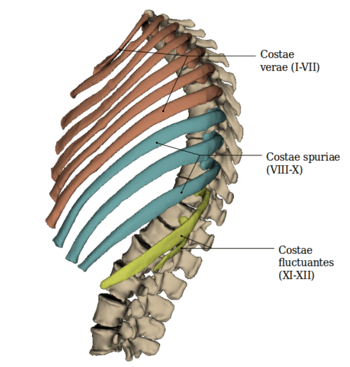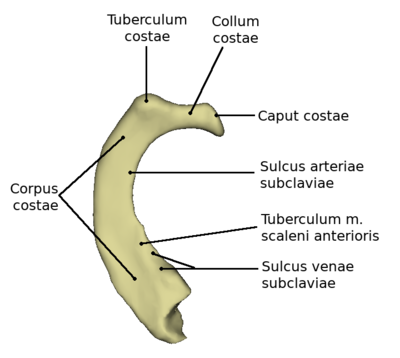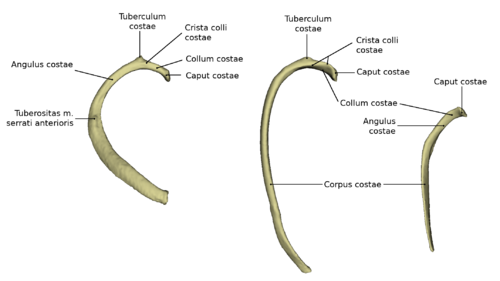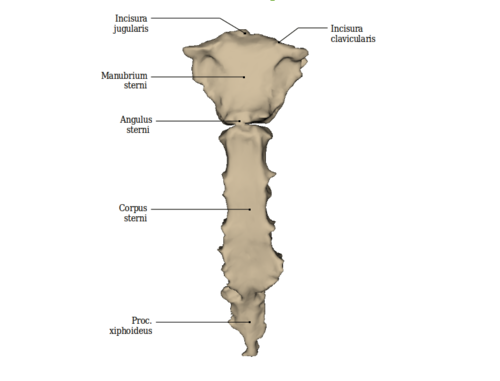Rippen und Brustbein/en: Unterschied zwischen den Versionen
Becher (Diskussion | Beiträge) (Die Seite wurde neu angelegt: „The first seven pairs of ribs reach the sternum directly as so-called real ribs (<i>Costae verae</i>).“) |
Becher (Diskussion | Beiträge) (Die Seite wurde neu angelegt: „The next five ribs are called false rib pairs (<i>Costae spuriae</i>). The 8th, 9th and 10th ribs are only indirectly connected to the sternum. The closest rib…“) |
||
| Zeile 31: | Zeile 31: | ||
The first seven pairs of ribs reach the sternum directly as so-called real ribs (<i>Costae verae</i>). | The first seven pairs of ribs reach the sternum directly as so-called real ribs (<i>Costae verae</i>). | ||
| − | + | The next five ribs are called false rib pairs (<i>Costae spuriae</i>). The 8th, 9th and 10th ribs are only indirectly connected to the sternum. The closest rib cartilages connect and are thus involved in the development of the costal arch (<i>Arcus costalis</i>). | |
Die beiden letzten "falschen" Rippenpaare (<i>Costae fluctuantes</i>) der 11. und 12. Rippe enden meist frei zwischen den Muskeln der seitlichen Bauchwand. | Die beiden letzten "falschen" Rippenpaare (<i>Costae fluctuantes</i>) der 11. und 12. Rippe enden meist frei zwischen den Muskeln der seitlichen Bauchwand. | ||
Version vom 2. Januar 2020, 14:17 Uhr
Inhaltsverzeichnis
Ribs
Ribs are paired, curved, rod-shaped bones that originate on the dorsal side of the thoracic spine.
Most ribs then reach the sternum in a semicircle.
In this way they create a cross connection between the two structures and thus serve the stability and elasticity of the thorax.
Usually the female thorax is narrower and shorter than the male.
A human has a total of twelve pairs of ribs, which corresponds to the number of thoracic vertebrae.
Each rib consists of the actual rib bone (Os costale) and an adjacent cartilage section, the rib cartilage (Cartilago costalis). The individual ribs do not border directly on each other, but are separated from each other by the intercostal space.
This space is partly filled by the intercostal muscles.
The rib heads connect the ribs to the spine in an articulated manner. Each rib touches two consecutive vertebrae. The articular surface of the rib head (Facies articularis capitis costae) is therefore divided into two parts.
The rib hump (Tuberculum costae) is located at the rib neck and is connected to the transverse process of the thoracic vertebra at the same level by a small articular surface (Facies articularis tuberculi costae). Not far from the rib neck is the Angulus costae (rib angle). The flat rib body has a convex outer surface (Facies externa) and a concave inner surface (Facies interna). The anterior part of the ribs consists of cartilage. This connects the ribs elastically to the sternum. Without this freedom of movement, the ribs would not be able to move with inhalation and expiration.
Classification of the ribs
The ribs can be divided into three groups. The connection to the sternum is decisive for this.
The first seven pairs of ribs reach the sternum directly as so-called real ribs (Costae verae).
The next five ribs are called false rib pairs (Costae spuriae). The 8th, 9th and 10th ribs are only indirectly connected to the sternum. The closest rib cartilages connect and are thus involved in the development of the costal arch (Arcus costalis).
Die beiden letzten "falschen" Rippenpaare (Costae fluctuantes) der 11. und 12. Rippe enden meist frei zwischen den Muskeln der seitlichen Bauchwand.
Unterschiedliche Rippenformen
Jedes Rippenpaar ist bilateral symmetrisch, die Form jedoch ist in jedem Segment verschieden. Der Rippenhals reicht vom Rippenköpfchen (Caput costae) bis zum Rippenhöckerchen (Tuberculum costae) und liegt am dorsalen Ende der Rippe. Er weist mit Ausnahme der 1. Rippe eine nach oben gerichtete Leiste (Crista colli costa) auf.
Lateral vom Rippenhöckerchen biegt sich der Rippenkörper (Corpus costae) unter Bildung des Rippenwinkels (Angulus costae) nach vorne um. Die Rippenkörper der 2.-11. Rippe weisen unregelmäßige Krümmungen auf, die sogenannten Flächen- und Kantenkrümmungen.
Durch ihre zusätzliche Verdrehung um die Längsachse sind die Außenflächen der Rippen an ihrem vertebralen Ende etwas nach kaudal, und an ihrem ventralen Ende leicht nach kranial geneigt. Normalerweise sind die 1. und 12. Rippe am kürzesten, und die 7. Rippe am längsten. Der Rippenknorpel wiederrum lässt nimmt von der 1.-7. Rippe an Länge zu, ab der 8. Rippe wird er wieder kürzer. Mit Ausnahme der 1., 11. und 12. Rippe besitzt jede Rippe an ihrer Unterfäche eine Furche (Sulcus costae), in dem die Interkostalgefäße und -nerven relativ geschützt verlaufen.
Brustbein
Das Brustbein ist ein platter, schwertförmiger und leicht nach vorn gewölbter Knochen. Die Seite des Brustbeins weist mehrere Einkerbungen (Incisurae costales) auf. Ventrale und laterale Ansicht des Brustbeins:
Das Brustbein kann in drei knöcherne Hauptabschnitte unterteilt werden: Handgriff (Manubrium sterni), Körper (Corpus sterni) und Schwertfortsatz (Processus xiphoideus).
Gut durch die Haut zu ertasten ist eine Einkerbung (Incisura jugularis) am kranialen Rand des Manubriums.
Die Vertiefungen Incisurae claviculares (rechts und links) ermöglichen die Verbindung zum jeweiligen Schlüsselbein.
Die flache Einkerbung (Incisura costalis I) darunter ist für die knorpelige Verbindung mit der ersten Rippe.
Die weiteren Einkerbungen (Incisura II-VII) sind für die knorpelige Verbindung mit den Rippen 2-7.
Am Angulus sterni ist der Handgriff gegen den Körper des Brustbeins leicht nach hinten abgeknickt.
Der Schwertfortsatz ist oft knorpelig und hat keine Verbindung zu einer Rippe.
Die knöcherne Struktur des Brustkorbes zum freien Explorieren
<segmenter border="1">https://dornheim.cloud/index.php/apps/segmenter/embedding/view?identifier=b7GTgSO6dYaQ</segmenter>
weiterführende Links





